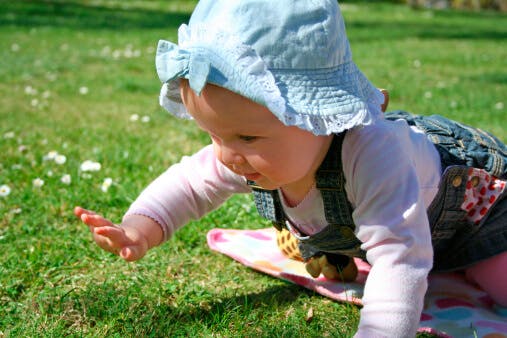Relieving Constipation With Diet

Question
What food should I feed my baby to keep her from getting constipated? She is 8 1/2 months old.
Dr. Greene's Answer
As long as your daughter is in diapers, every single bowel movement will be right there for you to see when her diaper is changed. During the diaper years, the stools undergo several changes. It makes sense to be asking about relieving constipation. The first bowel movements are the thick, sticky, tarry meconium stools formed while the baby is still inside you. During the first week, these give way, in breast-fed babies, to soft, yellow, breast-milk stools. These usually look like yellow mustard with little seeds. By the time a baby is one week old, she has an average of 8 to 10 of these pleasant (as stools go) stools each day. Formula-fed stools are often tan or yellow at this stage, and a little firmer than breast-milk stools. Either way, there are many dirty diapers!
By the time a baby starts solid foods, bowel movements have decreased to an average of once a day. Beginning solids usually produces a noticeable change in the character of the stools. They may be either softer or firmer, but they will likely smell worse (kids also smile and laugh more at this age, more than making up for the unpleasantness). Most children’s intestines are very responsive to the foods they eat.
Bananas, rice, soy, and products made from white flour tend to produce firmer stools. Pears, peaches, plums, apricots, peas and prunes make stools softer. By balancing the diet, you can often keep the stools comfortably mid-range.
Babies will normally strain from time to time to move the stool along through the intestines. If you want to do something when babies grunt, push, or strain, try picking them up to get gravity to help them in their efforts, or try holding the knees against the chest to help them “squat” — the natural position for bowel movements. Straining is usually normal. Crying while straining may be a sign of constipation.
When a child is constipated, the stool in the intestines has backed up more than it should. The longer stool sits in the colon, the more water is absorbed back into the body. When a child is constipated the stool tends to be hard, and passing it tends to be painful. Note that passing bowel movements less frequently does not necessarily mean that a child is constipated. Some children will naturally go through periods when they don’t have daily bowel movements. Some children may even go days without having a bowel movement. If they pass stool easily, softly, and without pain or blood, they are probably not constipated.
The simplest first step is to give the child more to drink to soften the stools. At the same time, readjust the balance of the foods in the diet to help.
If the stools are still too firm, juice is the gentlest medicine for relieving constipation. Apple juice twice a day is a good bet. If this doesn’t work, prune juice is even better. Baby food pureed prunes can also be used to soften the stools. In addition, when your daughter is straining you might want to put her in a tub of warm water. This will relax her muscles and make the stool easier to pass.
Glycerin suppositories can be very helpful if diet and juice don’t work, but overuse of suppositories can lead to dependence on them. Constipation stubborn enough to make suppositories necessary should be discussed with your pediatrician. The same holds true for baby laxatives (hint: if your pediatrician does recommend a laxative, 1/2 teaspoon of unprocessed bran, mixed with food twice a day, is about as effective as many laxatives and much cheaper).
With the right combination of foods, liquids, and medicines (if needed), every child should be able to have soft, comfortable stools. As they grow, their intestines will get less sensitive to the foods they eat. And someday soon, you will leave the diaper era entirely behind, and you will both get to enjoy life with no more dirty diapers!


